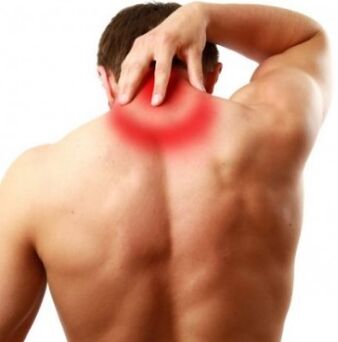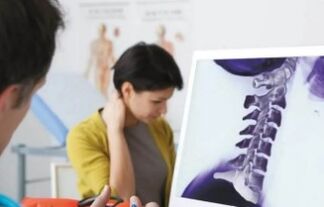Osteochondrosis is a spinal disease, characterized by the development of changes in the cartilage of the intervertebral disc and the reactive process in the surrounding tissue.
Cervical osteochondrosis backboneIt differs in its manifestations from thoracic and lumbar osteochondrosis.Symptoms of cervical osteochondrosis are associated with the features of the cervical spinal anatomy.The dimensions of the cervical region vertebra are less than the size of other departments.The cervical department is always burdened, holding the head, and at the same time it is very mobility.

The cause of osteochondrosis
The cause of the development of the disease, first of all, is due to age -related aging and the destruction of bone and cartilage.The following causes of osteochondrosis can also be called:
- Posture violations,
- Reducing motor activity due to inactive lifestyle,
- Excessive weight, which is the result of metabolic disorders, has a burden on the intervertebral disc,
- Factor factor,
- Long physical activity,
- spinal abnormalities.
Uniform physical activity, proper nutrition and healthy lifestyle significantly reduce the likelihood of developing the disease, and also reduces the effects of overall well -being.
Symptoms of cervical spinal osteochondrosis
The manifestation of cervical osteochondrosis is different from the symptoms of other spine.This is due to the fact that the cervical vertebra has a different structure and is very close.Therefore, any displacement is characterized by severe pain.In addition, bundle and nerve artery often pinch in the cervical spine.
Spinal cervical osteochondrosisIt is indicated by the following symptoms:
- Sensation of pain - pain can be felt in different parts of the body.This is due to the fact that pinching the nerve endings and muscles of the body.
- Disadvantages to the upper limbs themselves for pinching the nerve endings responsible for motor activity.
- Difficulty in turning heads, the appearance of vertebral collapse in the cervical region due to changes in the intervertebral disc structure, the appearance of bone formation.
- Low Hand Sensitivity.
- Weaknesses and dizziness arise from pinching the artery, which ensures blood and nutrition into the brain.
- Reduces hearing and vision - appears in the last stage of the disease, when the blood circulation in the cerebellum is interrupted.
Sign of osteochondrosis cervical department
- Rine syndrome - characterized by pinching the nerve beams in the neck.It is characterized by severe pain that can be felt on the shoulder, spatula.
- Vertebrate Syndrome - monitored by the strongest headache, pain in the temples and back of the head.
- Reflex syndrome - characterized by severe pain in the cervical region, which can be intensified by head movement.Pain can move to the shoulders and chest.
- Cardinal syndrome - resembles an angina pectoris attack, which is very difficult to determine.
Stage of development of cervical spine osteochondrosis
As it develops, the disease goes through several stages.Each level has its own features and is characterized by certain features.
- Stage 1. The vertebral bone tissue gradually begins to collapse.Symptoms of the disease are not significant.And patients who often do not realize it, but associate fatigue and pain with hard work and stress.
- Level 2. In height, the disc begins to decrease, cracks appear on it.Patients experience persistent pain, weakness, numbness.
- Level 3. Disc drops begin to form, vessels and cervical muscles are damaged.There were complaints about dizziness, pain in the back of the head.
- 4th stage.The bone tissue that protects the vertebra from excess load begins to grow, resulting in the nerve endings.There is stiffness in the movement, the neighboring joints are damaged.
The dangers of cervical osteochondrosis
A large number of nerves and arteries are located in the cervical region, which gives the brain nutrition.If they violate their work, the brain will not receive enough nutrition to function normal.This condition can violate one's motor activity, cause pain in the limbs, and loss of coordination.
In levels of osteochondrosis, ischemia, stroke and many other harmful diseases for human life can develop.
Therefore, when any symptoms associated with the disease arise, it is recommended to seek medical help.
Diagnosis of cervical spine
The following diagnostic types are used to check spinal disease:
- Picture X -ray is an ineffective way to diagnose the disease,
- MRI (magnetic resonance imaging) shows bone structure, forming disc hernia and their size,
- CT (computed tomography) is ineffective compared to MRI, because with the help of this diagnostic method it is difficult to determine the size of the hernia,
- The ultrasound duplex scan is used when the amount of blood flow is interrupted.This examination shows the existing blood flow velocity, as well as the presence of barriers in its journey.
Treatment of cervical spinal osteochondrosis

Treatment of cervical cervical osteochondrosis should be done in the complex depending on the condition.Positive effects can be achieved thanks to a comprehensive and individual approach, which includes drug treatment, physiotherapy, physiotherapy training, massage, and traditional medicine are also used.
During the period of disruption, the treatment of cervical osteochondrosis is intended to improve blood circulation, to eliminate muscle cramps.In this case, agents that increase blood flow, anti -inflammation and painkillers, and vitamin complexes are prescribed.
Media Physical Education for Cervical Area Osteochondrosis
Therapeutic gymnastics provide visible and less dangerous results at the recovery stage.The principle of physiotherapy exercise is to restore blood flow to the damaged parts of the body.Implementing physiotherapy exercises, patients cannot feel pain and difficulty.
The set of exercises for the cervical spine is designed to strengthen the neck muscles, and also act as a prevention for the development of cervical osteochondrosis.
Massage for cervical spine osteochondrosis
Massage is done to strengthen the tone in the muscles and relieve pain.Depending on the level of development of the disease, different massage methods are created.Classic massage techniques include:
- Promoting - This technique consists of effects on the surface layer of the skin.Massage begins with the collar area and continues to clavicula and armpits.
- Sprinkle - in this case, the effects of massage occur on the deeper layers of the skin.Bashening the neck with the thumb and the index is moving to catch the skin, which resembles a squeeze.
- Rubbing - done with the aim of heating and relieving the skin to increase blood supply to the cervical spine collar area.
- Kneading - has special restrictions, as it affects the fabric that is very lying.If this technique is done wrong, the patient can be dangerous.
In cases where the patient's pain only occurs on one side, the massage should begin to do from a healthy part of the neck, gradually moving to the cervical region where pain arises.
Massage can be done at home and in medical institutions.However, during its implementation, you must be careful not to cause the disease or do not do worse.
Prevention of cervical osteochondrosis
To prevent the occurrence and development of the disease, it is advisable to adhere to simple rules:
- Leading a healthy lifestyle, doing physical training, regularly visiting the pool;
- Diversify diet -rich foods with magnesium and calcium;
- In the case of inactive work, it is necessary to heat several times a day;
- To sleep, you need to choose orthopedic mattresses and comfortable pillows.






















